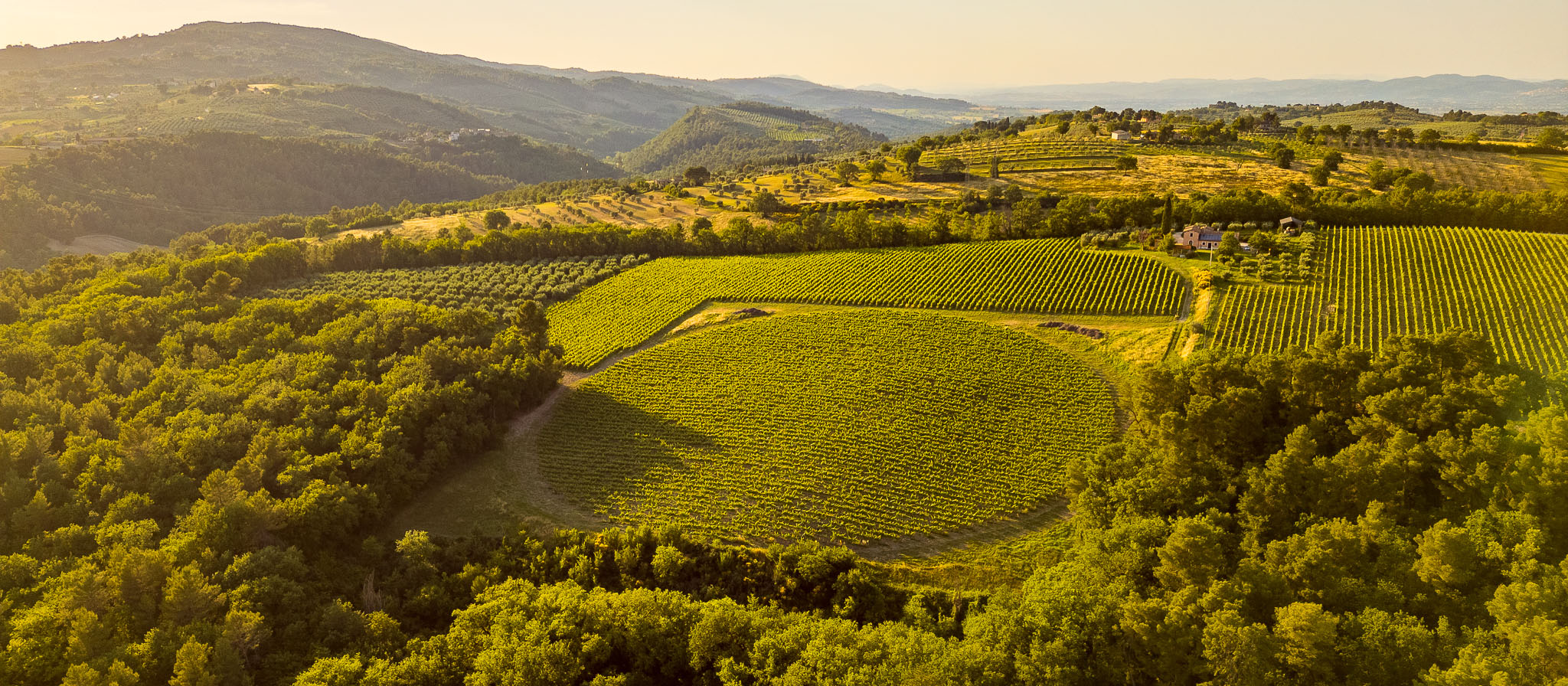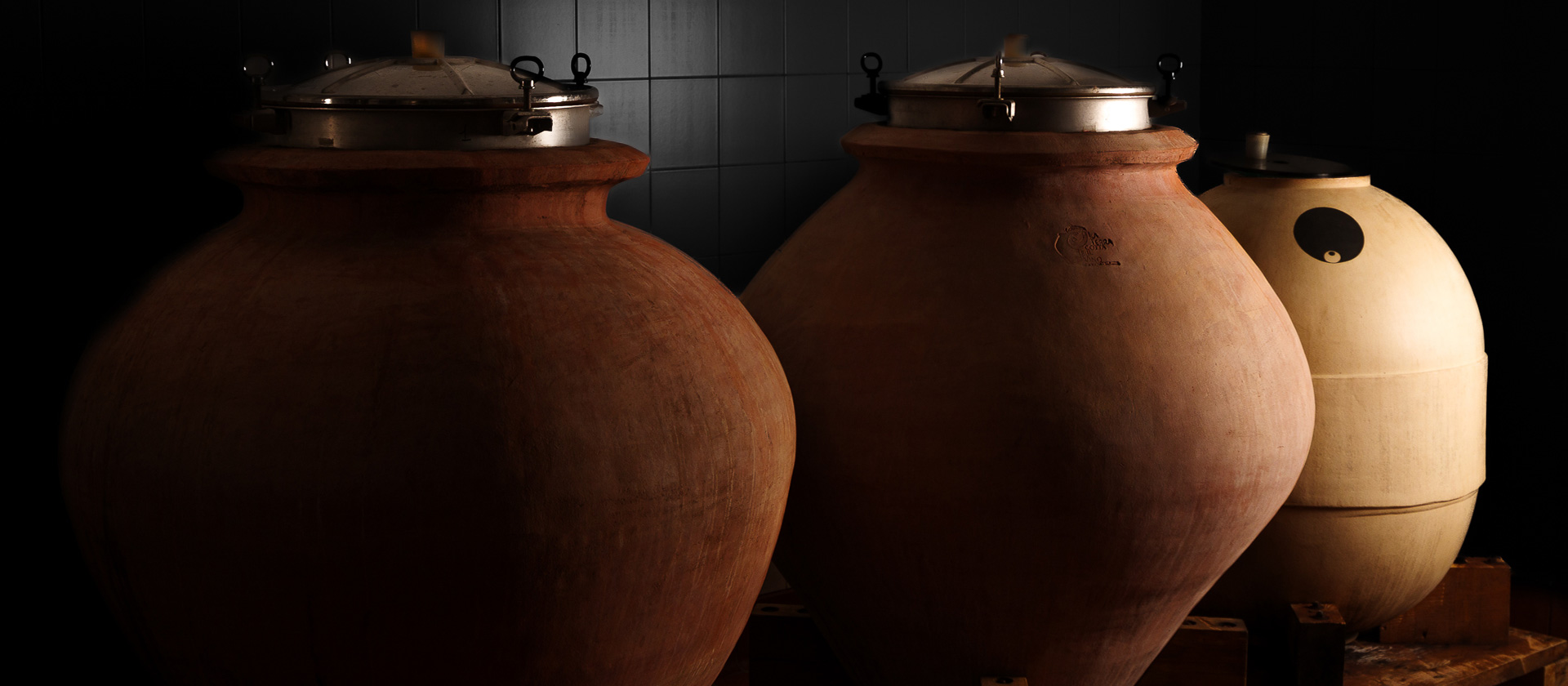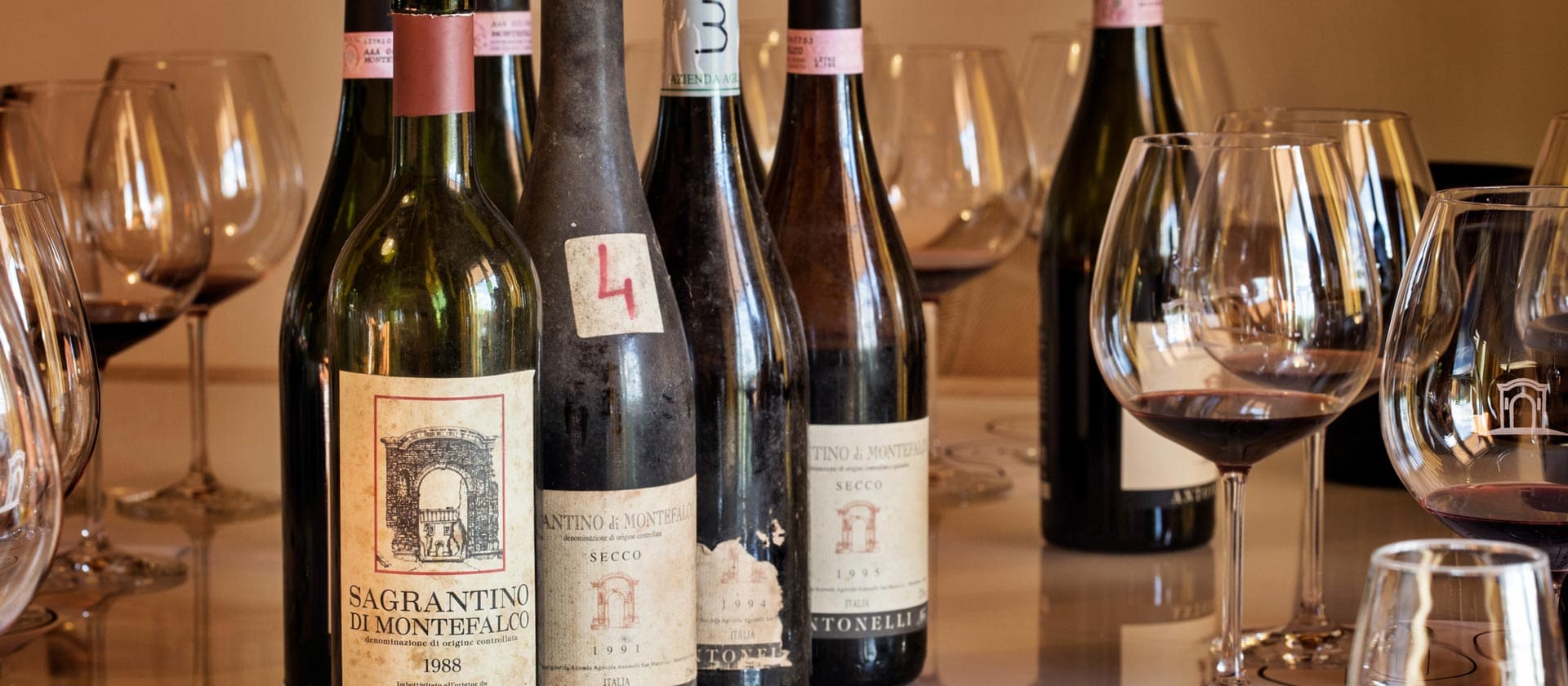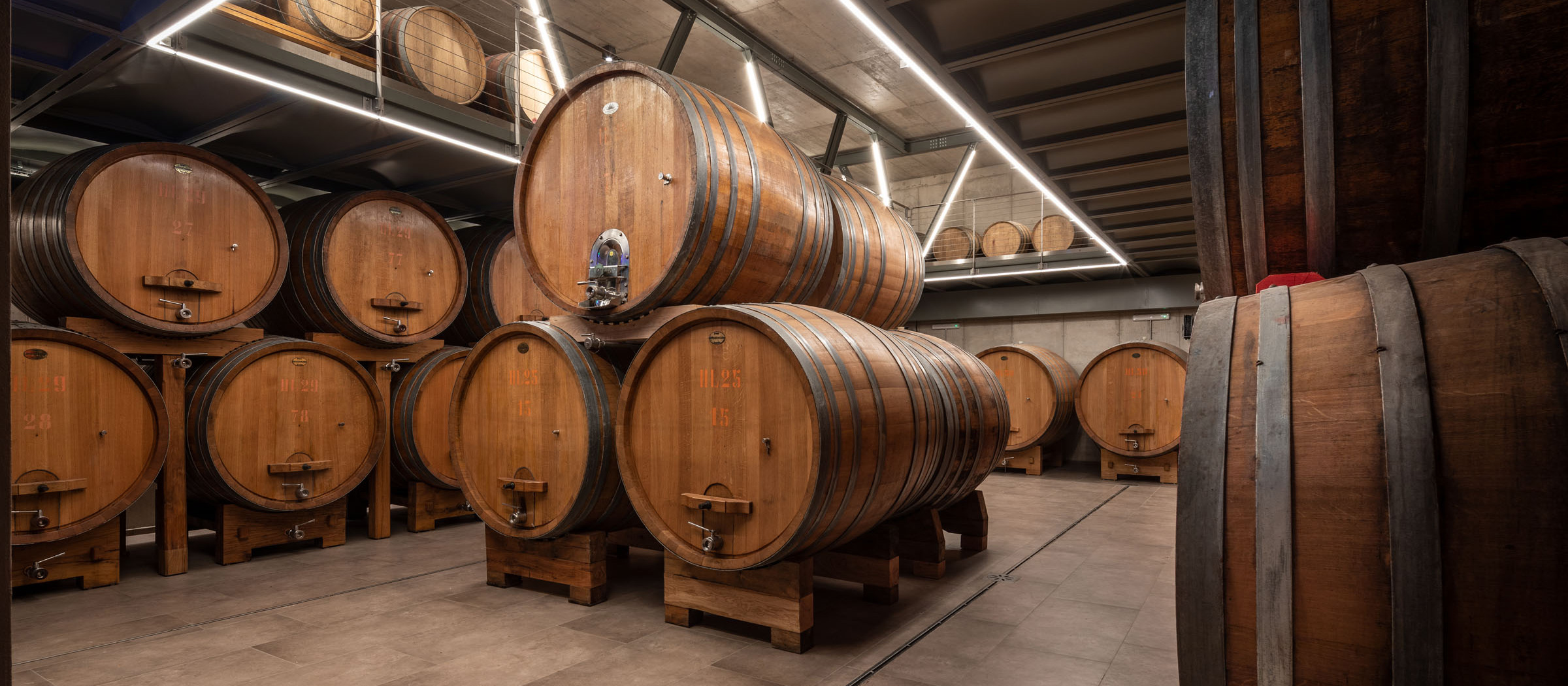


WINES

Our winery has always been characterized by respect for the most typical grape varieties of our production area. First and foremost, Sagrantino, an indigenous grape variety of Montefalco, on which we are carrying out a careful work of zoning, in order to bring out the best of its subtle perspectives determined by the vintages and vineyard positions. Not only with the two crus Chiusa di Pannone and Molino dell’Attone, made with grapes from two vineyards that are very different in terms of exposure and soil conformation, but also with the classic Montefalco Sagrantino docg, for which we carefully choose the best plots in our vineyards from year to year.
Similar work is being done with Trebbiano Spoletino. A grape variety that in fact disappeared for years, but was only partially forgotten until its recent rediscovery, which has finally given our production area the possibility of also producing white wines with a long and interesting perspective, in addition to the already well-known reds. Versatile and surprising grape variety for the results it gives back in relation to different vinification techniques to aging. Rediscovery path started with the Trebium Spoleto Trebbiano Spoletino doc, vinified and aged in large barrels. Continued with the “Vigna Tonda” cru, where we tested for the first time the long maceration in amphorae, made of ceramic, terracotta and cement. And finally 100% Trebbiano Spoletino in our Classic Method Dosage Zéro. Completing the set of red grape varieties are Sangiovese and others typical of central Italy, which are important for the Montefalco Rosso doc blend of the Riserva version, and Grechetto for the whites.
1985
It was one of the coolest January ever, temperatures even lower than -10°C were common. While the rest of the winter was rather warm and rainy, as spring was. Summer and first part of Autumn were balanced n terms of temperatures but dry. Wines were really well balanced with an elegant complexity to the nose and ageable.
1988
A very well balanced and warm year, rains were well distributed throughout all seasons and general conditions for grapes ripening were just optimal.
1989
A pretty good vintage but conditioned by rains during harvesting time.
1990
Characterized by a balanced climate trend for an optimal ripening status of grapes, and wines so reached a peak in terms of quality.
1991
A well balanced season that led to a good complexity and aromatic intensity of wines.
1992
Characterized by too many rains at the end of summer and autumn.
1993
As the year before rains in September and October were excessive.
1994
An early harvesting after a well balanced and warm year, with rains well distributed throughout all seasons. Balanced, complex and intense wines.
1995
Beginning of summer was really hot and September rainy. October finally was dry and warm for an optimal final ripening process, wines had not a lot of body, but a great elegance.
1996
August and September were rainy, causing a delay in phenological phases and so a late harvesting. Not much body in wines, but they were characterized by a good balance and interesting and fine aromas.
1997
It would have been a well balanced season if there weren’t the frosts we had in April. Those caused a lower production of grapes. Cool spring followed by a rainy month of June and then a rater dry summer. September and October ware warm and dry, leading to an early harvesting and really well balanced wines.
1998
Both spring and summer were really dry, July and August were scorching and they were followed by a cool and rather rainy Autumn. Wines were bodied and tannic, really fine as for complexity of aroma. It was and still is considered a very ageable Sagrantino vintage.
1999
Characterized by limited availability of water and by a general warmer than average climate trend from May to October. Few rains at the beginning of September helped vines for the last part of phenological phases. Early harvesting. Regular fermentations with high abv percentages. Full bodied but balanced wines in spite of the warm vintage.
2000
While spring and first part of summer were warm and dry, July and August were really hot. September finally showed a wide temperature gap between night and day and a few rains. Very early harvesting. Fermentations were really long because of the high alcohol potential of grapes. Very full bodied wines, but balanced and really interesting from a complexity of aromas point of view despite thee really warm vintage.
2001
A balanced vintage characterized by frosts in April that caused a lower than average production in terms of quantity. Even if July and August were really hot and dry a rainy winter and few rains between June and July helped the ripening process. September and October were just optimal. Regular fermentations, for wines that were not full bodied as the previous warmer vintages but really elegant and complex, especially for the Montefalco Sagrantino.
2002
Winter was rather warm and dry leading to a drought in spring and June, but then the rest of summer was exceptionally cool and rainy. Ripening process so was difficult and delayed, and we had to apply a strict selection of bunches in order to get some healthy grapes. Very late harvesting. Regular fermentations for thinner than usual wine body and fine and crisp aroma.
2003
Summer was really hot with a severe drought. Very early harvesting. Fermentations were really long because of the high alcohol potential of grapes.
2004
May and June were rather cool and rainy, so the first phenological phases occurred later than usual. But a well balanced Summer followed, both in terms of temperatures and rains, so that initial delay was recovered. Late harvesting of really healthy bunches, Sagrantino was harvested in the second half of October. Fermentations were regular for wines that didn’t show the body of warmer vintage, but had a very interesting and fin aroma. A really well ageable vintage.
2005
Characterized by a low production in terms of quantity because of a really hot first part of the summer, that became cool and rainy at the end of it. Another reason may be the cool March it was. Younger vineyards suffered for water scarcity. Late harvesting, Sagrantino was handpicked in the second half of October. Regular fermentation, good structure and body with an interesting aromatic richness.
2006
Characterised by cool temperatures throughout the year and subsequent phenological lag behind the norm. A rather dry and cold winter followed by a mild spring with little rain and a cool and rainy summer up to the end of August. Subsequently until mid-October there were higher temperatures and a dry weather which allowed optimal ripeness of the grapes.
2007
Characterized by warm temperatures throughout the whole season and by a lower production than average. Early harvest.
2008
Characterised by a cool and rainy spring that led to a phenological lag of about 10 days. During the summer there were average temperature and a dry weather, then in September and October we had northern winds which made the climate cool, dry and with a really low humidity, helpful for a healthy ripeness of grapes.
2009
A well balanced vintage throughout the whole year. Beginning of summer has been rather cool and rainy. Then the season has been characterized by a warm and dry weatjer unitl October.
2010
Characterised by a rainy spring that held to a lag in phenological phases. Summer has been rather cool until mid August. Subsequently until mid-October there were higher temperatures and a dry weather which allowed optimal ripeness of the grapes.
2011
Spring and first part of summer were characterised by a wide temperature range and few rains, so the ripening process was slow and irregular. Since the end of August and through the month of September climate has been dry and warm, with considerable temperature gap between night and day.
2012
It’s been a dry vintage throughout the year, with few rains. Winter and spring were rather dry, but while winter was cold, in spring we had a mild weather even if there were occasional frosts between April and May. Summer has been warmer than average and really dry. The final part of ripening process in September and October has been optimal thanks to a cool weather, good temperature gap between night and day and just the right amount of rain.
2013
Spring and first part of summer were cool and rainy, while the rest of the season hasn’t been too hot and characterised by a wide temperature gap between night and day. Beginning of Autumn has been rather rainy. Ripening process has been optimal but ended later than usual.
2014
Spring and first part of summer were rather cool and rainy, so that the beginning of the veraison happened around three weeks later than average. The rest of the summer has been regularly hot, with considerable temperature gap between night and day. nRipening process has been optimal, but later than usual.
2015
Very well balanced conditions throughout the whole production season. Winter has been rather rainy while spring has seen an high solar irradation and lots of winds. Summer has been dry, hot and sunny. Low humidity values made easy controlling vines health. Finally we had the right amount of rain in September and October for an optimal final ripening process of grapes. Late harvesting.
2016
A well balanced vintage. Spring was rather cool with a perfect amount of rain, Summer has been dry, but not too warm. While in September and October we had less rain than average and a wide range of temperatures between night and day. Phonelogical phases occured later than previous vintages, but ripening status has been optimal for all varietals. Late harvesting.
2017
Water scarcity was the key theme of the whole season. With drought conditions it rained little in winter and through the summer. Very hot temperatures, especially in July and August. Some frosts at the end of April caused a reduction in yield. Auspicious rains at the beginning of September helped the grapes to complete their ripening in a well balanced and timed manner.
2018
Second half of spring has been rainy and rather cool, making the phytosanitary control over mildew a complex task to accomplish. Especially for us, as an organic winery. Summer has been balanced throughout the season, never being too warm. The final ripening season, in September, was dry, leading to an optimal ripening status of grapes.
2019
Winter has been rater dry and mild in temperature, while spring has been cooler than average with frequent rains. Those conditions yielded about 10 days of delay in phenological phases. Even if June, July and August have been hot, we haven’t registered scorching temperatures during summer. Last part of summer and beginning of autumn have been dry and have shown a wide temperature gap between night and day, for an optimal developing of aroma precursors and ripening process. Harvesting has been later than usual.
2020
Characterized by a dry and not particularly harsh winter. Spring with frequent and heavy rains. Summer hot but without extremes of temperature and with some rain. Phenological phases in the normal range and regular veraison. Dry and cool second half of September that resulted in a slight delay in ripening of the later varieties (Sagrantino and Trebbiano Spoletino). Perfectly healthy grapes and optimal ripening.
2021
Winter with cold temperatures and heavy rains. Cold early spring and delayed sprouting that fortunately limited damage from a late frost on April 8. Late spring and summer with little rain and high temperatures but no extremes. Late ripening period and perfect health status of grapes.
2022
Characterized by abnormal temperature trends and poor water supply. Mild winter with little rain. Cold early spring. Slight delay in sprouting. Late spring and summer with high temperatures and no rainfall. The arrival of water in September allowed the plants to recover a good vegetative state and complete grape ripening. Average ripening time and perfect health status of the grapes.
2023
Much lower-than-normal grape productions of excellent quality. Winter with mild temperatures, early spring with normal temperatures and rainfall and regular vegetation development. Second half of spring and early summer with very frequent rainfall and low temperatures. Conditions that caused the slowing down of phenological stages, reduction of bunch weight and strong pressure of fungal infections on vegetation and grape production. The summer then continued with normal temperatures and low rainfall. Slightly early harvest with optimal grape ripening and perfect health status.